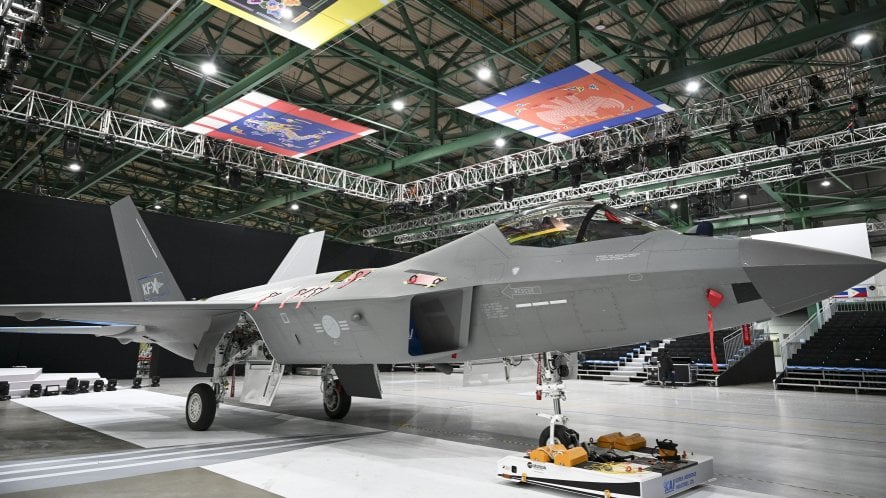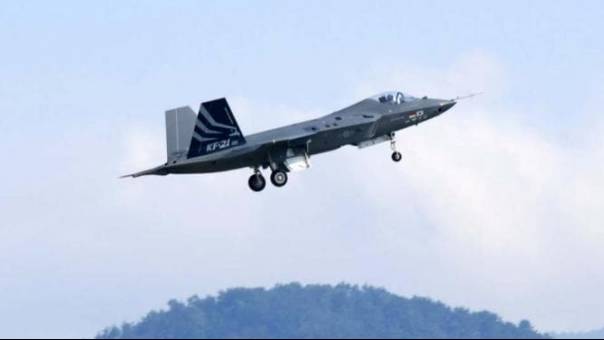I dont need to explain again and again the benefit Indonesia has on the program, basically that Turkey dude dont read this one :
1. Design experience
2. Some parts will be produced in Indonesia Aerospace for Indonesia/Korea/export market
3. Indonesian KF21 order will be assembled in Indonesia Aerospace
4. Composite material TOT that is also useful for other program
5. System integration will be more complex than transport one, so once again gaining huge experience and increase capabily
6. Maintenance market will be handled by Indonesia Aerospace for IFX and possibly for SEA market as well
7. Indonesian Aerospace can develop STEALTH wing man drone and it means huge market even within Indonesia market alone as one KF21 is planned to have 3 wingman drone accompanying them.
8. Possibly long production benefit for Indonesia Aerospace as even the plane is planned to be developed further into 6 generation fighter
9. Improving Indonesia Aerospace brand image and also the program can improve nation brand image that can benefit many business in Indonesia that wants to export high tech product or advanced service to overseas market
10. Indonesia Aerospace will get 1 prototype that can be used to develop Indonesian engineers capability and develop Indonesian version of KFX with possibly more local component
-------------------------------------------
Regarding the fuselage part produced in Indonesia Aerospace
In the KF-21/IFX project, the national defense industry involved is PT Dirgantara Indonesia. "As a result of initial discussions with South Korea, PT Dirgantara Indonesia (Persero) asked to be the sole supplier (50 percent) of wings, tails, and other parts or (pylons)," said the Public Relations Bureau of the Ministry of Foreign Affairs.
Korea Selatan bersama Indonesia mengembangkan pesawat tempur yang kini dinamai KF-21 Boramae. Langkah itu dapat menjadi tonggak pencapaian menuju kemandirian.

www.kompas.id
-----------------------------------------------
Regarding design experience
Indonesia delays payment for S. Korea's fighter development project
All News 11:49 October 07, 2019
"Despite such a delay in payment, the Indonesian side has continued to send its researchers to South Korea to take part in the development process," Rep. Kim Joong-ro of the minor opposition Bareunmirae Party said during a parliamentary audit into the administration, voicing concern about technology leaks.
As of July, 114 Indonesian engineers were sent to South Korea to work with Korea Aerospace Industries Co. (KAI), the country's sole aircraft manufacturer, to design and make a prototype of the fighter, according to a DAPA official.
SEOUL, Oct. 7 (Yonhap) -- Indonesia is in arrears on its payment obligations for a joint p...

en.yna.co.kr
-----------------------------
February 6, 2014 (Angkasa/Space Magazine)
KFX / IFX program continued , Government Asked to Immediately Selecting Design
Korea was once considered Indonesia engineer do not understand about the design of a jet fighter. But the notion was quickly turned , when the Indonesian team describes the design and the various inputs. The Indonesian side also the one who finally managed to convince that the aircraft take-off weight of 50,000 pounds must .
Confirmation of the Parliament of South Korea on the resumption of the program KFX / IFX team warmly welcomed designers from Indonesia. They include asking both governments immediately call the engineers involved in preparing work that has been long overdue. They also want the governments of both countries to make sure one of the two designs that have been produced in the Technology Development phase for cultivation in the next phase .
"Program KFX / IFX is a multi - program years , costly, and involve various sectors and foreign partners. For that there must be a definite declaration on it goes. For Indonesia it is important to determine the financing schemes and their human resources planning, "
said Dr Rais Zain, M. Eng , KFX / IFX Configuration Design Leader for Angkasa , in late January.
"In the near future Indonesia will also work on the N219 and R - 80. We do not have enough engineers to work three programs, especially KFX / IFX will take place until the 2020s. The government is expected to call home engineers who are now working abroad to come help the regeneration process. Outside there are approximately 200 people . If half of it can be returned to the country, it is enough to help, " added Rais who is also a lecturer at the Faculty of Aerospace Engineering ITB, Bandung.
As reported by the national media, the confirmation of the continuation of the program of making front - liner Korean - Indonesian fighter jets received by the Ministry of Defense on January 3, 2014. Notice is further announced Defense Minister Purnomo Yusgiantoro told reporters, Wednesday, January 8, 2014, on the sidelines of Rapim Kemenhan in Jakarta. Explanations related to exposure delivered weapon system procurement plans in the Strategic Plan II, 2015-2019.
The Indonesian government hopes the project of making the 4.5 generation fighter jet could be done because it would be a referral program to remove the dependence of the transfer of technology from other countries. Besides KFX / IFX, Indonesia is also pursuing a program of making submarines , warships, propellants , rockets, and tank size medium. For submarines, Indonesia is also cooperating with the same country.
Superior to the Su - 35 Program, KFX / IFX was stopped temporarily by Korea's new leader Park Geun - Hye end of 2012 after reviewing the state financially in the country.
This prestigious project was worked on since the beginning of 2011, shortly after President Lee Myung - bak and President Susilo Bambang Yudhoyono confirmed the bilateral cooperation in the defense field in Jakarta. From the Technology Development Phase that has been completed, a team of scientists has completed a number of conical design that later became two.
The two designs is a model of the stealth fighter jet -winning twin-engine air superiority with horizontally - tails in the back, and the other one is with canards on the front. "Each has consequences different financing and partners. Thus , it must first be decided which one is selected. It is important that when followed, all parties are ready to do it , "said Rais Zain , whose day-to- day lecturer at the Faculty of Engineering, Aerospace Engineering,ITB, Bandung.
As stated Wamenhan Sjafrie, Korean parliament has prepared 20 million U.S. dollars (temporary , Indonesia : $ 5 million) to continue this program in 2015. At that time , the team will go to the Engineering Manufacturing Development Phase. In addition must have a high thrust engine with a power to be able to fight in the air, the aircraft must also have weapons stored in the internal weapons bay , the data - link capable of randomizing communications, advanced radar target voters, and anti - jamming device.
The prototype is expected to finish by the end of the Strategic Plan II . Even if there are things that need to be criticized , it is a matter of operation requirements are much more determined the Korean Air Force . This was inevitable because the Korean bear 80 percent of the funding, and the country actually have a real enemy. This program is targeted to spawn a jet fighter with performance equivalent or superior to the opponent fighter jets which are the Sukhoi Su - 35.
Prerequisites requirement dismissed the proposed counter designs by KAI ( Korean Aerospace Industrie) recently, which is intended to cut development costs. In the configuration ( see Space, December 2013 ), looks KFX type E is only one engine powered with weapons outside the radar sweep prone opponent.
Angkasa examine admiration of ADD ( Agency for Defense Development, Defence Research and Development Agency of Korea ) submitted to the Indonesian engineer team. Initially, the team assumes Korea really had no idea about the design of Indonesian fighter jets.
However, the assumption was turned when Indonesian engineers began to describe the design and the various inputs to the design of Korea. The Indonesian side also who ultimately ensure that the aircraft must have a takeoff weight of 50,000 pounds.(A.Darmawan/Angkasa magazine).
Angkasa Online - Majalah Aviasi dan Militer
web.archive.org
See the year of 2012 ( Before KAI Korea and Lockheed Martin join the program in 2015)
Indonesian wind tunnel










![Korean President Yoon Suk-yeol, left, shakes hands with Indonesian President Joko Widodo, at the presidential office in Yongsan District, central Seoul Thursday afternoon. [JOINT PRESS CORPS] Korean President Yoon Suk-yeol, left, shakes hands with Indonesian President Joko Widodo, at the presidential office in Yongsan District, central Seoul Thursday afternoon. [JOINT PRESS CORPS]](/proxy.php?image=https%3A%2F%2Fkoreajoongangdaily.joins.com%2Fdata%2Fphoto%2F2022%2F07%2F28%2F74f38181-53a1-46cf-afc1-e1f6134036ab.jpg&hash=6ed2fa12598d216a211cbac6095492d9)
![Korean President Yoon Suk-yeol, right, holds a joint press conference with Indonesian President Joko Widodo, after their bilateral summit at the presidential office in Yongsan District, central Seoul Thursday. [JOINT PRESS CORPS] Korean President Yoon Suk-yeol, right, holds a joint press conference with Indonesian President Joko Widodo, after their bilateral summit at the presidential office in Yongsan District, central Seoul Thursday. [JOINT PRESS CORPS]](/proxy.php?image=https%3A%2F%2Fkoreajoongangdaily.joins.com%2Fdata%2Fphoto%2F2022%2F07%2F28%2Fe690c968-07a1-46d2-bc7e-e92c8dc73154.jpg&hash=336115f1b3d2a766e508fc4045360630)
